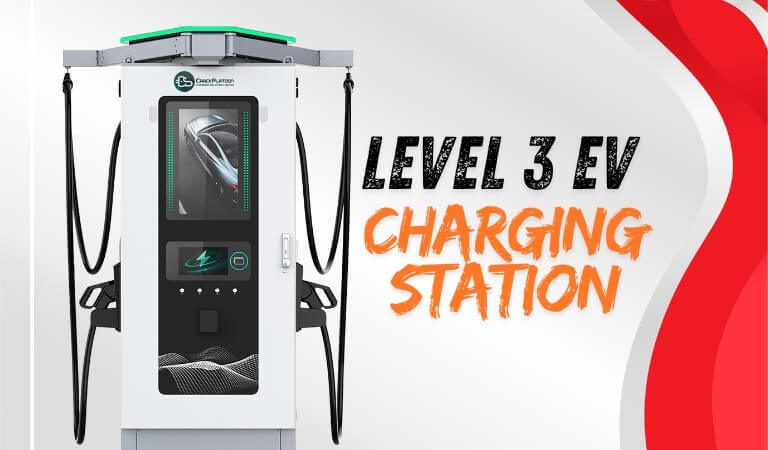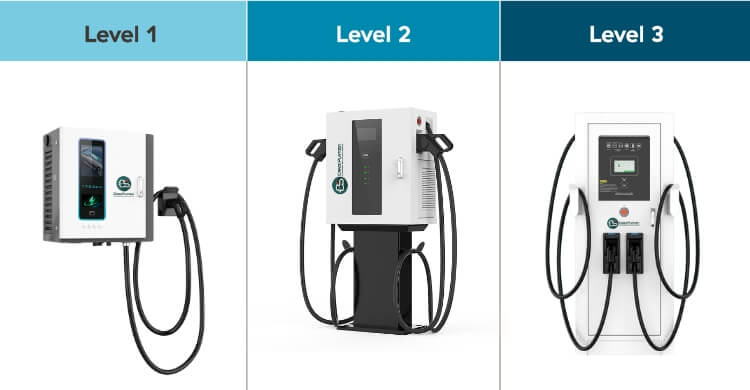Electric vehicles (EVs) have gained popularity in recent years, changing the way we think about transportation. As the popularity of electric vehicles rises, users are actively looking for convenient and quick charging options. This has led to the development of various EV charging stations, each designed to meet different charging needs. Among these, a Level 3 EV Charging Station stands out as one of the most efficient options. But the question is: What is a Level 3 EV charging station?
A Level 3 EV charging station is a high-speed charging station that uses DC (direct current) to rapidly charge electric vehicles. Also known as DC fast chargers, they can recharge an EV battery up to 80% in 20–30 minutes, which makes them perfect for long-distance travel and quick charging.
The following article explains the advantages and features of Level 3 charging stations and how you can make the most of them. So stay tuned with us.
What Is a Level 3 EV Charging Station?
A Level 3 EV charging Station is a fast-charging solution for electric vehicles. It helps drivers quickly recharge their EVs, especially during long trips. These stations are a great solution for those who need speed and convenience while charging their electric vehicles. Here are some of the features that make it so popular:

Faster Charging Time
One of the standout features is the quick charging time. Level 3 stations can charge an EV to 80% in just 20-30 minutes. This is much faster than most home or public chargers. It helps reduce downtime and is perfect for those on the go.
High Power Output
Level 3 chargers are capable of delivering much higher power than other types. They typically offer a range of 50-350 kW. This high power output makes the fast charging possible. It is the reason why these stations are often used along highways and major roads.
Ideal for Long-Distance Travel
Level 3 EV Charging Stations are perfect for long-distance travel. They allow drivers to quickly recharge their electric vehicles while on the road. In many regions across the world, especially in growing Asian countries like Bangladesh, access to fast charging is becoming essential. That’s why public services like electric vehicle charging stations in Bangladesh are being developed to meet growing EV needs.
Widespread Availability
You’ll find Level 3 stations in key locations, especially in high-traffic areas. These chargers are commonly located at highway rest stops and near major retail centers. Availability has been increasing as more EVs hit the road. Many companies are expanding their networks of fast chargers.
Compatibility with Modern EVs
Most modern electric vehicles support Level 3 charging. It’s important to check if your EV is compatible with this type of charger. Many automakers now design vehicles to be compatible with fast-charging technology. As EV technology improves, compatibility continues to grow.
When Should You Use a Level 3 EV Charger Instead of Level 2 and Level 1 Chargers?
When choosing the right charger for your electric vehicle (EV), it’s important to know the options available. Each charger type offers different speeds and benefits, depending on your needs. You can save time and improve your EV experience by knowing when to use a faster charger. Listed below are details about when you should use a Level 3 EV charger instead of a Level 2 or Level 1 charger:

When You’re in a Rush
Being short on time means you need the fastest charging option available. A Level 3 EV charger can recharge your battery quickly. These chargers often provide up to 80% power in just 20–30 minutes. That makes them ideal for people with busy schedules and tight timelines.
For Long Road Trips
Long drives require reliable and fast charging to keep you moving. Level 3 chargers are found along highways for quick top-ups. Slower chargers may leave you waiting too long on the road. That’s why fast-charging stations are best suited for extended travel days.
In Case of Limited Time
Short breaks during the day demand faster charging than what home chargers can offer. Level 3 chargers are built for such situations. They deliver energy faster, so you don’t waste precious time. Choosing a slower charger may not suit your busy routine.
Understanding Charging Needs
Before deciding on fast charging, you should be aware of the differences between Level 1 and Level 2 chargers, especially in charging speed. Level 1 is best for overnight use, while Level 2 suits daily charging at home or work. Both are slower than Level 3, which delivers power much faster. Choosing the right level depends on how quickly you need your EV ready.
Availability of Charging Stations
Public spaces now offer more fast-charging options than ever before. Level 3 stations are found at highways, malls, and service areas. These spots make it easier to charge while you’re doing something else. The wide placement helps with both daily and long-distance travel.
For Quick Stops in Urban Areas
Busy city life often means limited time to charge your vehicle. Level 3 chargers let you top off your battery quickly. Many are installed near shopping areas or parking lots for easy access. That makes charging less of a task and more of a convenience.
Do All New EVs Come with Level 3 Charging Capability?
No, not all new electric vehicles (EVs) come with Level 3 charging capability built in. Some newer models include it, while others don’t. It often depends on the brand, model, and price of the EV. Buyers should always check the car’s features before assuming Level 3 charging is included.
Luxury and high-end EVs are more likely to support Level 3 fast charging right from the factory. Budget-friendly or smaller models might only support Level 1 and Level 2 charging. In some cases, Level 3 capability is offered as an optional upgrade. It’s important to ask the dealer or check the official specifications.
Even if the car supports Level 3, the right plug type must also match the available station. Some brands use different charging connectors for fast charging. This can affect where and how you use Level 3 stations. Always make sure the charging port is compatible with your local fast-charging networks.
What Factors Influence the Growth of Fast Charging Networks Globally?
The growth of fast charging networks is essential for the broader adoption of electric vehicles (EVs). As more people switch to EVs, the need for efficient and accessible charging stations increases. Globally, there are several factors that influence the growth of fast-charging networks. Here are the details about these factors:

Government Support and Policies
Many governments are providing grants, funds, and smart policies to support EV charging. They also encourage private companies to build more fast chargers everywhere. Some even offer tax cuts or help with setup costs for chargers. These actions make it easier and faster to grow charging networks.
Increase in Electric Vehicle Sales
With more people buying electric cars, the need for faster charging is going up. Many new EVs are built to handle fast charging. Drivers want quicker charge times and more stations in public areas. That demand pushes businesses to grow their fast-charging networks quickly.
Private Sector Investment
Lots of private companies are jumping in to build and grow fast-charging stations around the world. They see a chance to grow as more people drive EVs. Energy companies, carmakers, and tech brands are working together. Their investments help speed up network growth across cities and highways.
Public Awareness and Convenience
More people now understand how EV charging works and want fast chargers in easy-to-reach places. In Asian countries like Bangladesh, public awareness is growing as more people switch to electric vehicles. The availability of free EV Charging Stations in Bangladesh is also encouraging drivers to consider EVs for daily use. This rising demand is helping fast-charging networks grow where people actually need them.
Urban and Highway Planning
When cities plan roads, parking lots, or buildings, they now include EV charging as part of the design. You’ll see fast chargers at malls, offices, and big parking areas. Highways are adding fast-charging spots for long road trips as well. Smart planning makes it easier for people to charge on the go.
Advancements in Charging Technology
Fast charging tech is improving quickly, making chargers faster and more reliable than before. New models can charge your EV in under 30 minutes. That’s a big step up from older chargers. These updates make fast charging much easier and more attractive for drivers.
Top Tips to Find Level 3 Charging Stations
Finding Level 3 charging stations is easier when you know where to look and what tools to use. These chargers help you power up your EV quickly, especially during long drives. Here are some simple and smart tips to help you find them with ease.
- Use EV Charging Apps: EV apps like PlugShare and ChargePoint help locate nearby stations with real-time updates. They also show if the charger is available.
- Check Navigation Systems: Many EVs have built-in maps that display nearby Level 3 stations. These maps often include details like speed, price, and status.
- Look Near Highways and Main Roads: Level 3 chargers are often placed along highways for easy access during road trips. These locations are chosen for convenience and traffic flow.
- Visit Shopping Centers and Malls: Some malls and large shopping areas now offer fast chargers for customer use. Charging while shopping makes efficient use of time.
- Use Online Maps Like Google Maps: Typing “Level 3 charging stations” in Google Maps gives accurate results. It shows stations, reviews, and even charger types available.
- Ask at Dealerships or Service Centers: EV dealerships may provide fast charging or know local spots. Staff can often suggest stations other EV owners trust and use.
- Check with Charging Network Providers: Companies like Electrify America and EVgo list station locations on their websites. These tools are helpful when planning longer road trips.
- Join EV Communities or Forums: Electric vehicle groups often share tips on reliable charging spots. Learning from other EV drivers can save time and reduce stress.
FAQs About What Is a Level 3 EV Charging Station?
Below you will find some frequently asked questions about Level 3 EV Charging Stations. These answers will give you a deeper insight into the functionality, benefits, and practical aspects of using Level 3 chargers. Take a look.
Can I Use a Level 3 Charger at Home?
Level 3 chargers are typically not designed for home use due to their high power output. These chargers require specialized equipment and electrical infrastructure that is usually found at public charging stations. For home use, Level 1 or Level 2 chargers are more appropriate and safe.
Are Level 3 Charging Stations More Expensive to Use?
Yes, using a Level 3 charging station is typically more expensive than using Level 1 or Level 2 chargers. The higher cost is due to the faster service, the equipment required, and sometimes the location, such as along highways or in busy commercial areas.
Can All Electric Vehicles Use Level 3 Charging?
Not all electric vehicles (EVs) are compatible with Level 3 charging. Older or budget EV models may only support Level 1 or Level 2 charging. It’s always a good idea to check your vehicle’s specifications to ensure it can handle Level 3 fast-charging capabilities.
How Long Does It Take to Charge an EV with a Level 3 Charger?
A Level 3 charger can charge most EVs up to 80% in as little as 20 to 30 minutes. This makes it an excellent option for those on a time crunch, especially during long trips or short breaks. However, the full charge time may vary depending on the vehicle’s battery capacity.
Are There Any Safety Concerns With Level 3 Charging Stations?
Level 3 chargers are safe to use, but they do involve higher power levels than home chargers, so it’s crucial to use stations that meet safety standards. Most public Level 3 chargers are designed with multiple safety features to ensure safe operation for users and their vehicles.
Is Level 3 Charging Available Everywhere?
While Level 3 charging stations are expanding globally, they are still not as widespread as Level 2 chargers. However, they are increasingly available in high-traffic locations, highways, and major cities. You’ll likely find more of them in regions with higher EV adoption rates.
What Are The Environmental Benefits of Using Level 3 Charging Stations?
Level 3 chargers help reduce charging time, encouraging people to drive electric vehicles more often. This, in turn, supports the environment by lowering emissions. Although the chargers use more energy, they are part of a larger shift toward clean, sustainable transportation that benefits the planet.
Are Level 3 Charging Stations Free?
Level 3 charging stations are typically not free, although some may offer complimentary charging as part of a promotional event or a membership benefit. Most stations charge based on the amount of energy consumed or the time spent charging, so fees can vary.
Bottom Line
As electric vehicles become more common, knowing how to charge them quickly is now a part of everyday life. Level 3 EV Charging Stations offer the fastest solution, ideal for road trips, tight schedules, or emergencies. They use direct current (DC) to power up an EV in just 20–30 minutes.
Being aware of what is a Level 3 EV Charging Station helps drivers make smart choices when time and convenience matter most. These chargers are widely available, especially along highways, in cities, and near busy areas. Though not all EVs support Level 3 charging, more models are being built with that capability. Whether you’re a new EV owner or just curious, using Level 3 charging wisely can make your EV experience smoother, faster, and more flexible.
